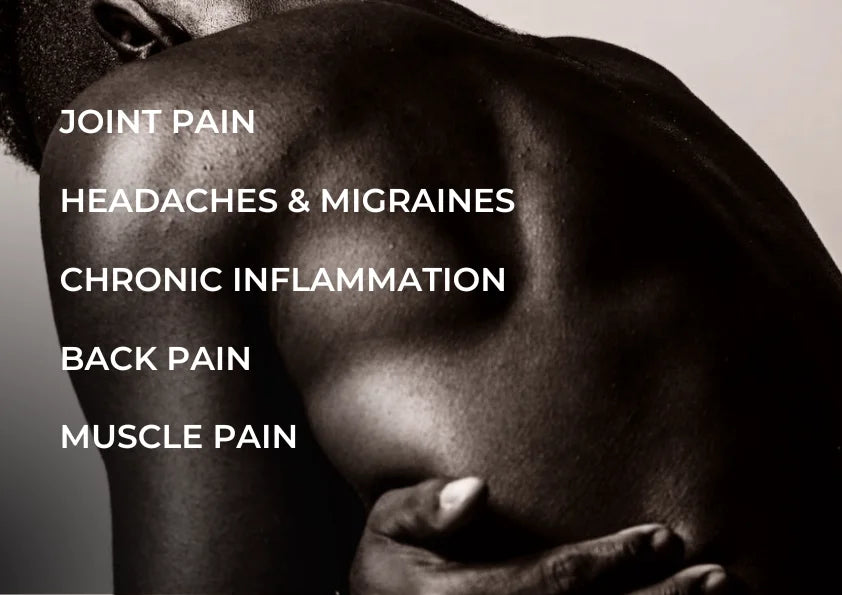
Inflammation & Pain
Red light therapy is a natural, non-invasive cellular treatment supported by over 6,000 studies. It targets a range of areas, including the management and elimination of pain and inflammation.
Red light therapy has been found to be effective in reducing inflammation and relieving pain. By targeting the affected areas with red light of the appropriate wavelength and intensity, it triggers physiological responses that help alleviate these symptoms.
One of the key mechanisms by which red light therapy reduces inflammation is by modulating the immune response. It helps to regulate the production of pro-inflammatory molecules, such as cytokines, and encourages the release of anti-inflammatory substances. This rebalancing effect helps to decrease inflammation in the affected tissues and promotes a more optimal healing environment.
Red light therapy also stimulates the production of nitric oxide, which has vasodilatory effects. This means that it helps widen the blood vessels, improving blood circulation to the affected area. Enhanced blood flow brings in more oxygen and nutrients while removing waste products, promoting tissue repair and reducing inflammation.
In terms of pain relief, red light therapy has analgesic properties. It can help reduce pain sensation by inhibiting the transmission of pain signals and modulating nerve activity. Additionally, red light therapy promotes the release of endorphins, which are natural pain-relieving substances produced by the body. This can contribute to the overall reduction of pain and discomfort.
Moreover, red light therapy has been shown to improve joint function and reduce pain associated with conditions such as arthritis. By stimulating the mitochondria in the joint tissues, it enhances cellular energy production, leading to improved tissue repair and reduced inflammation in the joints.
In summary, red light therapy provides effective relief for inflammation and pain. It modulates the immune response, improves blood circulation, and stimulates the release of endorphins, all of which contribute to reducing inflammation and alleviating pain in various conditions and injuries.
Unmanaged inflammation leads to accumulated oxidative stress which has a knock-on effect, compromising the structure and function of various proteins, lipids and acids. This can lead to a variety of inflammation-fuelled diseases such as diabetes, autoimmunity, obesity and neurodegeneration.


Inflammation & Pain
Red Light Therapy Study #1
Lower back pain is a problem that is estimated to impact over 80% of all adults at some stage of their lives.
This study assessed 40 individuals who had suffered back pain consistently for six or more years).
Of the forty participants, 21 received near-infrared light therapy and the remainder were in the placebo control group. They provided an overall pain rating, and pain with rotating and bending – movements difficult to perform with back pain.
The treatment group initially scored their overall pain 6.9/10, which dropped to 3/10 after the series of treatments. The drop of 3.9 points is almost three times the decrease of the placebo group, at 1.4.
The study demonstrates impressive results given the length of time the individuals had been in pain. Other pain conditions that have strong clinical backing include back and neck pain, fibromyalgia, knee pain, chronic joint disorders, sacroiliac joint pain, tendinitis and myofascial pain, chronic elbow and wrist pain.
For full study CLICK HERE.


Inflammation & Pain
Red Light Therapy Study #2
This review of a number of studies, focussing on inflammation and red and near-infrared light therapy, gives an overview of the effects on a variety of conditions including Achilles tendinopathy, thyroiditis, muscle tissue fatigue, psoriasis, arthritis and alopecia areata.
Positive results were consistently found throughout, including increased blood flow, lowered pain scores, decreased autoimmune attack on the thyroid tissue, fewer inflammatory markers in muscle tissue and increased hair growth in over 50% of those with alopecia areata.
While exact understanding around how these results are achieved for each individual issue is still being established, it appears there is both a local effect (where the cells directly exposed to light receive one benefit) as well as a systemic effect (where distant tissues and organs also benefit).
For full study CLICK HERE.
To see the full database of studies of red and near-infrared light therapy and how it can support pain relief and alleviate tissue inflammation CLICK HERE.
SOHL Range

- Regular price
-
$449.00 - Regular price
-
$0.00 - Sale price
-
$449.00
- Regular price
-
$799.00 - Regular price
-
- Sale price
-
$799.00
- Regular price
-
$1,699.00 - Regular price
-
- Sale price
-
$1,699.00
- Regular price
-
$2,499.00 - Regular price
-
- Sale price
-
$2,499.00
- Regular price
-
$3,499.00 - Regular price
-
- Sale price
-
$3,499.00
- Regular price
-
$5,999.00 - Regular price
-
- Sale price
-
$5,999.00


